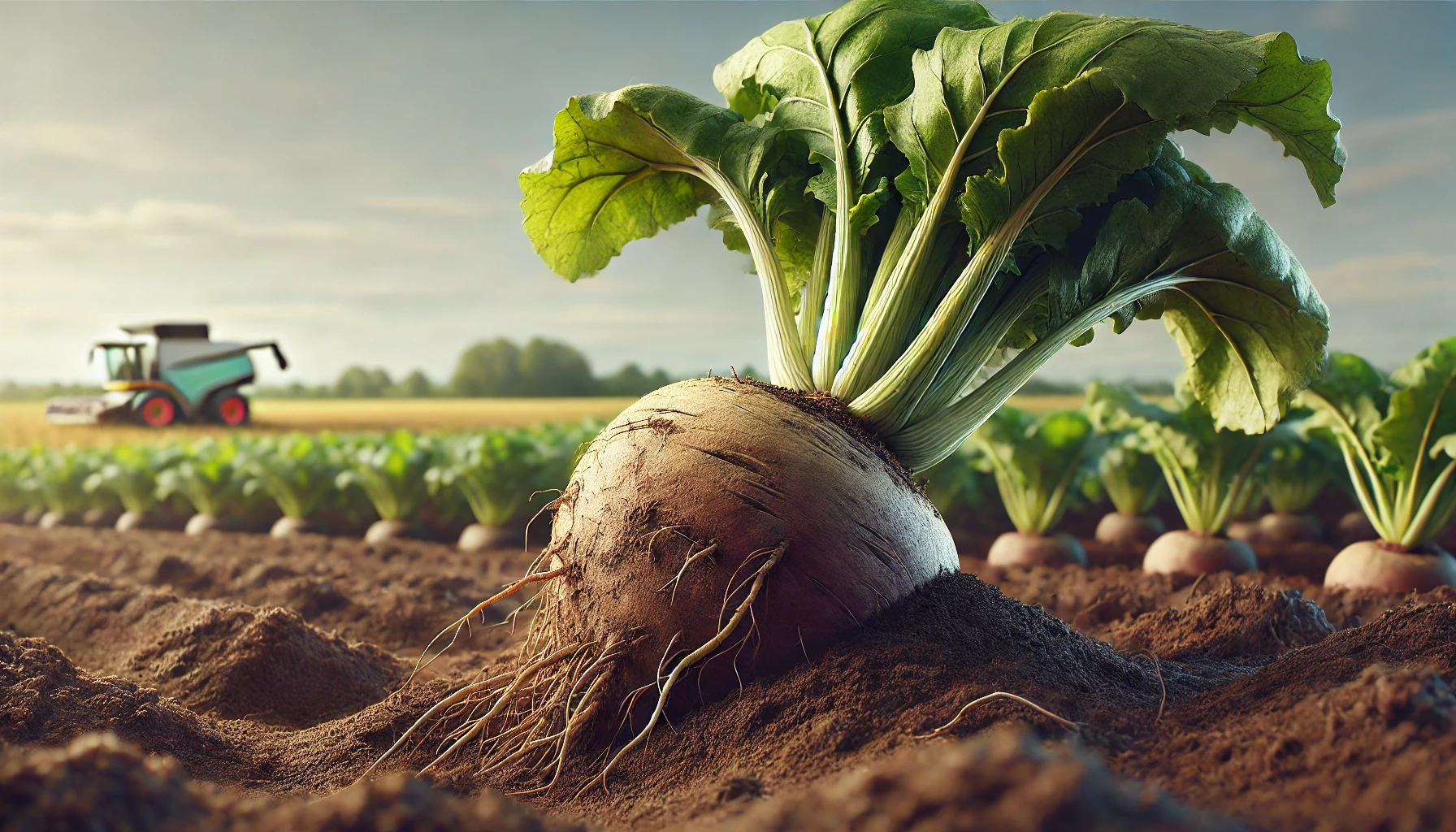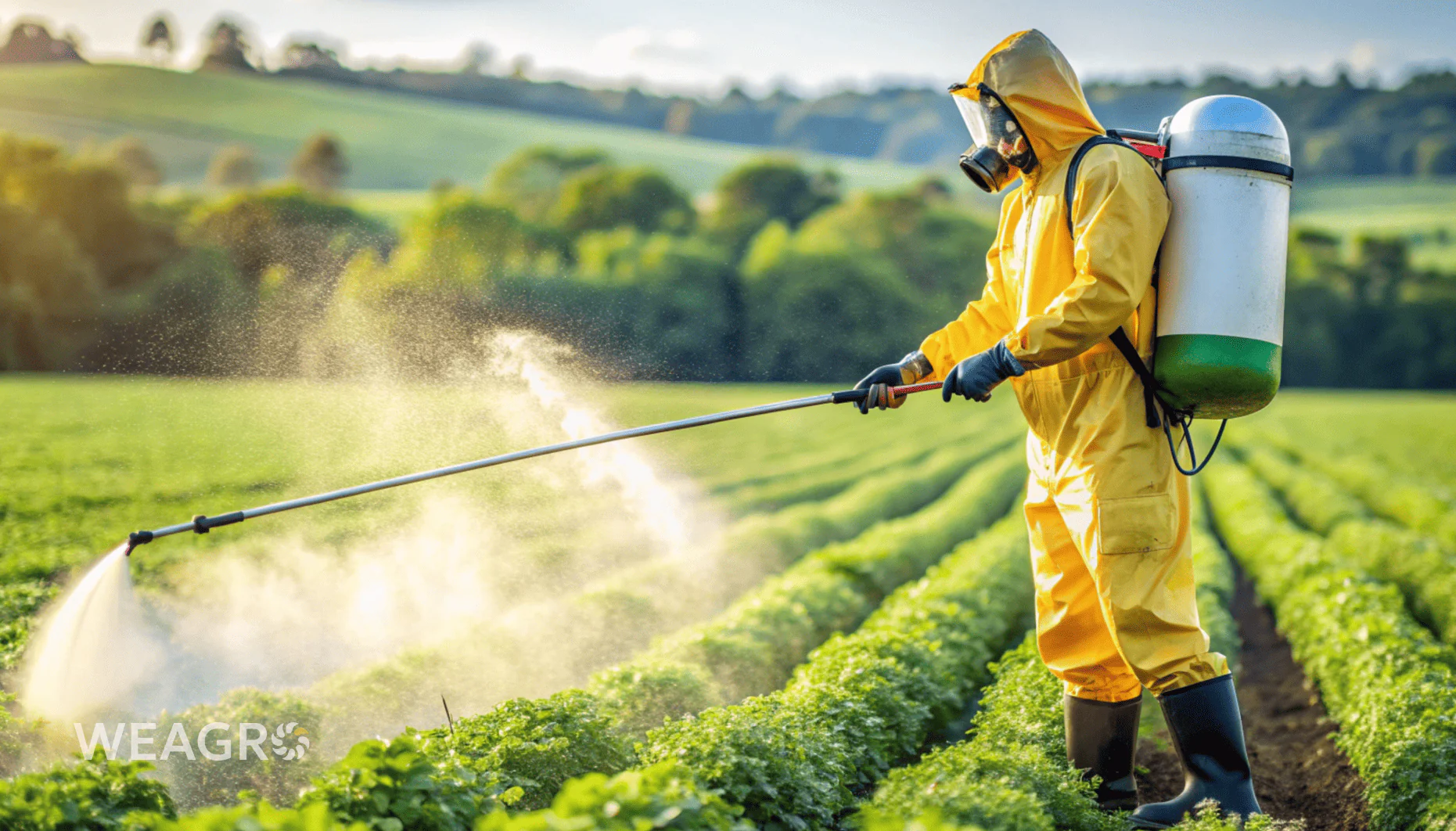Sugar beet is one of Ukraine’s strategic agricultural crops, and the country holds a leading position among European countries in its production. Thanks to our country’s favorable climate zone, sugar beet is profitable to grow in many regions. After the start of military actions in Ukraine in 2022, many farmers renewed their interest in this crop. This is due to logistical problems during the sale of traditionally leading crops – corn and wheat. As of April 2024, 238.7 thousand hectares of land have been sown with this plant. This indicator determines the potential for both domestic consumption and export.
Sugar Beet: Crop Description
Sugar beet is a biennial root crop plant, one of the most important crops in agriculture, as its roots are used to produce sugar, which is used in the food industry and many other sectors.
The sugar beet root has a cylindrical or conical shape and typically weighs from 0.5 to 1.5 kg. Its color varies from white to light yellow. The plant has a well-developed root system that allows it to effectively absorb water and nutrients from the soil. Sugar beet is a cold-resistant crop that tolerates spring frosts well.
Beet processing by-products (pulp and molasses) are used as animal feed and raw material for biogas plants, making this crop important not only for the food industry but also for the energy sector.
Sugar Beet Yield

According to 2023 data, the average sugar beet yield in Ukraine was 50-55 tons per hectare. The highest yields are observed in the central and western regions of Ukraine, where climatic conditions are most favorable for growing this crop.
Yield depends on many factors, including agricultural practices, climatic conditions, soil fertility, and the use of modern technologies. High yields are achieved through proper sugar beet cultivation: variety selection, crop rotation adherence, and planting density optimization. Timely treatment against diseases and pests is important. It is also crucial to provide the plant with organic and mineral fertilizers. Insufficient soil moisture leads to reduced yield and root quality.
Read also: Organic fertilizers: what they are, types and application rates
Sugar Beet Growing Technology
To achieve high results and ensure stable production levels of this crop, it is necessary to follow sugar beet growing technology.
Sugar Beet: Growing Conditions
Sugar beet grows best in moderate climate conditions with sufficient rainfall and warmth. In Ukraine, the most favorable regions for sugar beet growth are the central, western, and partially northern regions. These zones are characterized by a moderately continental climate with even distribution of precipitation throughout the growing season and optimal temperature conditions.
Climatic conditions favorable for sugar beet cultivation:
- Average daily temperature of 18-25°C.
- Rainfall from 600 to 700 mm per year.
- Stable temperatures during root development.
Regarding soils, sugar beet cultivation is best organized on fertile, structured soils with good water permeability and sufficient aeration. Chernozems, sandy loam, and loamy soils with neutral or slightly acidic reaction (pH 6.0-7.5) are most suitable. Heavy clay and waterlogged soils should be avoided as they poorly transmit water and air.
Sugar Beet Cultivation Map in Ukraine

Sugar Beet: Sowing
Sugar beet sowing is conducted in spring when the soil warms up to 5-7°C.
When to Sow Sugar Beet
The optimal sowing time for sugar beets in Ukraine is from late March to mid-April. It’s important to consider weather conditions and soil temperature, as early sowing allows maximum use of spring moisture and ensures rapid plant growth.
Soil Preparation for Sugar Beet Sowing
For successful sugar beet cultivation, proper soil preparation is essential. Deep plowing (25-30 cm) in autumn promotes better soil aeration, weed and pest control. Organic fertilizers such as manure or compost are applied at this stage. Early spring harrowing is performed to loosen the topsoil and retain moisture. Before sowing, the soil is cultivated to level the surface and create optimal conditions for seed sowing. To ensure optimal soil reaction (pH 6.0-7.5), liming is performed, which improves soil structure and increases nutrient availability for plants.
Read also: Cultivator: What It Is and How to Choose Correctly
Today, all necessary agricultural products can be purchased with installment payments up to 180 days. This opportunity is offered by the online service WEAGRO. This is an online service where farmers can conclude purchase agreements with suppliers with installment payments and receive orders on the day of approval. Interaction occurs remotely and requires no paper documents, and the installment is provided without collateral.
Sugar Beet Predecessors
Proper sugar beet predecessors help maintain soil moisture, structure, and nutrient accumulation. These are the following crops:
- Winter wheat, barley, oats – leave the soil in good physical condition and enrich it with organic residues.
- Peas, soybeans – contribute to soil nitrogen enrichment through symbiosis with nitrogen-fixing microorganisms.
- Potatoes, cabbage – leave the soil in good condition but require thorough weed control.
Repeated cultivation of sugar beet in the same field is possible no earlier than 3-4 years to prevent pest and disease accumulation.
Sugar Beet Seeding Rate
Sugar beet seeding rates vary depending on climatic conditions, soil type, and variety. The optimal seeding rate ensures uniform plant distribution in the field, promoting better development and increased yield. The sugar beet seeding rate is 12-20 kg/ha. Plant density is 80-120 thousand plants per hectare. Optimal density depends on variety and growing conditions.
Sugar Beet Sowing Method
Various methods are used in sugar beet cultivation, each with its advantages and disadvantages.
For example, traditional row sowing, where seeds are sown in rows with 45-50 cm spacing, is very simple to implement and effective, but if plants are unevenly distributed, it will complicate inter-row maintenance.
With broadcast sowing, seeds are sown evenly across the entire field area. This reduces soil compaction risk, but there are drawbacks – difficulty in crop maintenance and high seed cost.
Strip sowing involves planting seeds in strips with 50-70 cm spacing between strips and 15-20 cm between rows within the strip. This method requires specialized equipment but is very convenient for inter-row maintenance.
The optimal sowing depth in all cases is 2-3 cm.
Using modern precision seeders in sugar beet cultivation allows for uniform seed placement in the field, promoting optimal plant development and increased yield. GPS navigation, automatic depth control, and seeding rate control ensure maximum efficiency and minimal losses.
Sugar Beet Care
Sugar beet requires regular moisture, especially during active root development. The optimal irrigation regime is 3-4 times per season with 30-40 mm of water per irrigation. Excessive moisture can lead to root rot.
Sugar beet fertilization is critical for ensuring high yield and product quality. It provides plants with necessary nutrients and improves soil structure. Planting cover crops (mustard, alfalfa) as green manure before sugar beet sowing helps enrich the soil with organic matter.
Sugar Beet Pests
Sugar beet suffers from various pests that can significantly reduce yield. The main sugar beet pests are the beet weevil, which damages leaves and roots, and aphids that suck sap from leaves.
In the first case, manual collection of beetles helps, as well as using biological preparations based on bacteria or fungi that affect pests. For aphids, spraying plants with nettle, garlic, or tobacco infusion is needed.
Modern technologies also help in controlling sugar beet pests. This includes using drones for field monitoring and early pest detection, as well as digital platforms for data analysis and selecting optimal pest control methods.
Read also: Precision Farming in Ukraine: Definition and Prospects
Sugar Beet Diseases
Sugar beet is susceptible to various diseases that can reduce crop quality and yield. Root rot, caused by fungi, is one of them. Prevention includes seed treatment with biofungicides, crop rotation adherence, and ensuring good soil drainage.
Another common sugar beet disease is cercospora leaf spot, a fungal disease that appears as gray spots on leaves. In this case, spraying with biofungicides, removing affected leaves, and ensuring good ventilation between plants helps.
Preventing sugar beet diseases is aided by using sensor-based monitoring systems for early disease detection, as well as data analysis using machine learning algorithms to predict disease outbreaks and develop effective control strategies.
Sugar Beet Varieties
Several main sugar beet varieties are grown in Ukraine, each with its own characteristics and advantages.
| Variety Name | Characteristics | Advantages |
| Bilotserkivskyi | Drought resistant, high sugar content | Excellent yield even in unfavorable conditions, high sugar content |
| Yarovyi | Early maturity, pest resistance | Possibility of early harvesting, reduced pest losses |
| Kyivskyi | High disease resistance, good frost tolerance | Lower crop losses due to diseases, possibility of cultivation in colder regions |
| Poltavskyi | Medium maturity, high adaptation to different soils | High yield on various soil types, stable sugar content |
| Kharkivskyi | High pest resistance, medium sugar content | Reduced plant protection costs, stable yield |
Conclusion
Sugar beet is one of the key crops in Ukraine’s agricultural sector. Among the reasons for the spread of sugar beet cultivation are the ability to ensure not only sugar production but also the development of livestock farming and bioenergy. Given the stable demand for sugar in the domestic market and export opportunities, sugar beet cultivation remains economically viable. Support from state agricultural sector development programs also contributes to increasing areas under this crop.
Innovative technologies for monitoring plant condition, pests, and diseases allow increasing sugar beet cultivation efficiency and reducing chemical use. For example, using drones and satellites for field monitoring allows farmers to obtain accurate information about plant development, soil condition, moisture, and pest presence.
Installing sensors in fields to measure soil and air parameters (temperature, humidity, nutrient levels) provides constant monitoring of growing conditions.
Using biological plant protection methods (biopesticides, biopreparations) allows effective pest and disease control without environmental harm.
Sugar beet cultivation becomes more profitable with agricultural installment payments from the online service WEAGRO. Through our online service, every farmer can choose a reliable agricultural supplier and conclude a purchase agreement with deferred payment up to 180 days. This is convenient and profitable, as agricultural installment is approved within 30 minutes, requires no collateral, and is not affected by exchange rate fluctuations.
Overall, the prospects for sugar beet cultivation in Ukraine are quite promising, which will contribute to the further development of the country’s agricultural sector.









